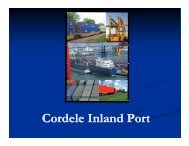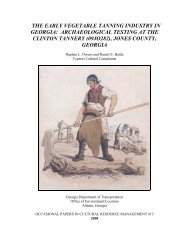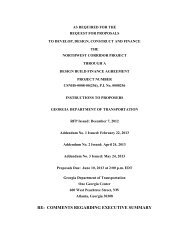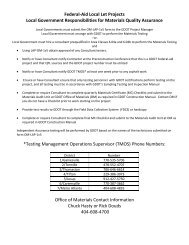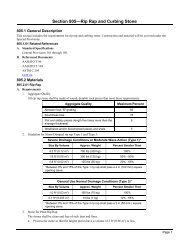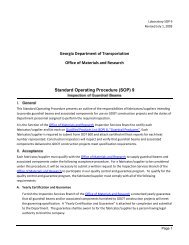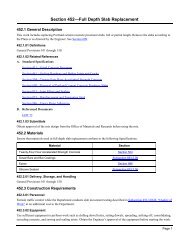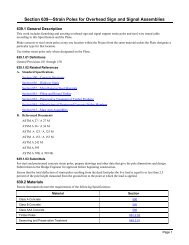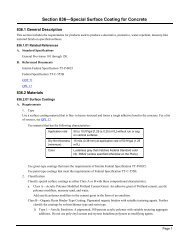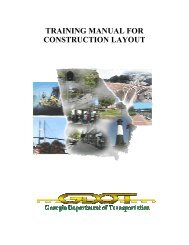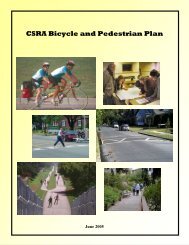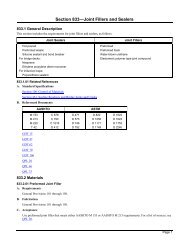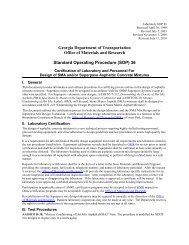Section 304 Soil Aggregate Construction
Section 304 Soil Aggregate Construction
Section 304 Soil Aggregate Construction
Create successful ePaper yourself
Turn your PDF publications into a flip-book with our unique Google optimized e-Paper software.
<strong>304</strong>.1 General Description<br />
<strong>Section</strong> <strong>304</strong>—<strong>Soil</strong> <strong>Aggregate</strong> <strong>Construction</strong><br />
This work includes constructing base, subbase, or shoulder courses composed of mineral aggregate and soil mortar on<br />
prepared subgrade or subbase. Construct according to these Specifications and to the lines, grades, thickness, and crosssections<br />
shown on the Plans or established by the Engineer.<br />
All of the provisions of <strong>Section</strong> 300 apply to this work.<br />
<strong>304</strong>.1.01 Definitions<br />
General Provisions 101 through 150.<br />
<strong>304</strong>.1.02 Related References<br />
A. Standard Specifications<br />
<strong>Section</strong> 105—Control of Work<br />
<strong>Section</strong> 109—Measurement and Payment<br />
<strong>Section</strong> 300—General Specifications for Base and Subbase Courses<br />
<strong>Section</strong> 412—Bituminous Prime<br />
<strong>Section</strong> 816—<strong>Soil</strong> <strong>Aggregate</strong> Bases<br />
B. Referenced Documents<br />
GDT 21<br />
GDT 49<br />
GDT 59<br />
<strong>304</strong>.1.03 Submittals<br />
General Provisions 101 through 150.<br />
<strong>304</strong>.2 Materials<br />
Ensure that materials meet the requirements of the following Specifications:<br />
Material<br />
<strong>Section</strong><br />
<strong>Soil</strong> <strong>Aggregate</strong> Base 816.2.01<br />
<strong>Soil</strong> Mortar for <strong>Soil</strong> <strong>Aggregate</strong> Base 816.2.02<br />
Bituminous Prime 412<br />
<strong>304</strong>.2.01 Delivery, Storage, and Handling<br />
General Provisions 101 through 150.<br />
<strong>304</strong>.3 <strong>Construction</strong> Requirements<br />
<strong>304</strong>.3.01 Personnel<br />
General Provisions 101 through 150.<br />
<strong>304</strong>.3.02 Equipment<br />
Provide equipment in satisfactory condition for proper construction. Use any applicable equipment as specified in<br />
Subsection 412.3.02, “Equipment” for Bituminous Prime.<br />
Page 1
<strong>Section</strong> <strong>304</strong>—<strong>Soil</strong> <strong>Aggregate</strong> <strong>Construction</strong><br />
<strong>304</strong>.3.03 Preparation<br />
Prepare the subgrade or subbase as specified in Subsection 300.3.03.C, “Preparing the Subgrade” or Subsection 300.3.03.D,<br />
“Preparing the Subbase.” Place soil aggregate materials only on a dry, thawed foundation.<br />
<strong>304</strong>.3.04 Fabrication<br />
General Provisions 101 through 150.<br />
<strong>304</strong>.3.05 <strong>Construction</strong><br />
A. Methods<br />
1. Use any of the methods of mixing material described in <strong>Section</strong> 300.<br />
2. In lieu of the methods of mixing described in <strong>Section</strong> 300 and when approved by the Engineer, use one of the<br />
following methods:<br />
a. Produce soil aggregate from an approved source or deposit.<br />
1) Produce soil aggregate base that will meet the requirements of this Specification after it has been mined,<br />
crushed, and processed.<br />
2) Stockpile the processed material before delivery to the Project.<br />
3) Keep the stockpile large enough during loading operations to ensure that a uniformly blended material is<br />
delivered to the Project.<br />
4) Use equipment that will not segregate the material during loading.<br />
b. Produce a soil aggregate using in-place operations<br />
B. Placing Material<br />
1) Mix one material with the existing roadbed materials.<br />
2) Mix two materials on a prepared subgrade.<br />
Use the following steps to spread and mix base, subbase, or shoulder course.<br />
1. Spreading and Mixing<br />
a. When using soil aggregate base produced from an approved source, uniformly spread the material with an<br />
approved mechanical spreader to obtain the desired thickness. Compact and finish according to Subsection<br />
<strong>304</strong>.3.05.C, “Compacting and Finishing.”<br />
b. When in-place operations are required, use the following procedures for either mixing one material with the<br />
existing roadbed materials or mixing two materials on a prepared subgrade:<br />
C. Compacting and Finishing<br />
1) Uniformly spread the material with an approved mechanical spreader to obtain the desired thickness<br />
when mixing two materials on a prepared subgrade. When mixing only one material with the existing<br />
roadbed materials, the material may be dumped directly on the subgrade and spread uniformly.<br />
2) After spreading material, and as soon as weather and moisture conditions permit, mix it by plowing,<br />
harrowing, and blading.<br />
3) Without disturbing the underlying subgrade or subbase, plow the material to its full depth, then harrow<br />
with a disc harrow.<br />
4) Begin plowing alternately at the edges and the center, back and forth, as many times as necessary to<br />
produce a thoroughly pulverized and homogeneous mixture.<br />
5) Compact and finish according to Subsection <strong>304</strong>.3.05.C, “Compacting and Finishing.”<br />
Construct courses to the maximum thickness as specified in Subsection 300.3.05.C.5, “Compaction.”<br />
Page 2
<strong>Section</strong> <strong>304</strong>—<strong>Soil</strong> <strong>Aggregate</strong> <strong>Construction</strong><br />
Use the following steps to compact and finish a base, subbase, or shoulder course:<br />
1. Moisture Content<br />
Ensure that the moisture content of materials is uniformly distributed and allows compaction to the specified<br />
density. Add sufficient water during the mixing operations to provide the optimum moisture content, ± 2 percentage<br />
points.<br />
2. Compaction<br />
After placing and shaping the material to line and grade, compact it to 98 percent of the maximum dry density as<br />
determined by representative samples, using GDT 49. When using the material as a base for paved shoulders 6 ft<br />
(1.8 m) wide or less, compact to at least 96 percent of the maximum dry density.<br />
a. One-Course <strong>Construction</strong><br />
1) After compaction, shape to the required grade, line, and cross-section.<br />
2) Add water as necessary to develop the proper moisture content.<br />
3) Roll until the surface is smooth, closely knit, and free of cracks.<br />
4) Correct all defects according to Subsection 300.3.06.B, “Repairing Defects”.<br />
b. Multiple Course <strong>Construction</strong><br />
1) After compacting the first course, shape the surface again to line, grade, and cross-section.<br />
2) Add water as necessary to develop the proper moisture content.<br />
3) Spread and compact the second and any succeeding courses without rolling the first course again.<br />
4) Finish the surface according to the procedure specified for one-course construction.<br />
c. Irregular Areas<br />
D. Priming Base<br />
In places inaccessible to the roller, obtain the required compaction with mechanical tampers approved by the<br />
Engineer.<br />
After completing the base, apply bituminous prime according to <strong>Section</strong> 412.<br />
<strong>304</strong>.3.06 Quality Acceptance<br />
A. Compaction<br />
Determine the maximum dry density from representative samples of compaction material according to GDT 49.<br />
Determine the in-place density according to GDT 21 or GDT 59.<br />
B. Finished Surface<br />
1. Transverse Check<br />
Check the finished surface of the base, subbase, or shoulder course transversely. Using one of the following tools:<br />
A template, cut true to the required cross- section and set with a spirit level on non-superelevated sections<br />
A system of ordinates, measured from a stringline<br />
A surveyor’s level<br />
2. Longitudinal Check<br />
Check the surface longitudinally by placing a 15 ft (4.5 m) straightedge parallel to the centerline.<br />
Ensure that ordinates measured from the bottom of the template, stringline, or straightedge to the surface do not exceed<br />
1/4 in (6 mm) at any point. Rod readings shall not deviate more than 0.02 foot (6 mm) from the required readings.<br />
Immediately correct any variations that exceed the requirements, as specified in Subsection 300.3.06.B, “Repairing<br />
Defects.”<br />
Page 3
<strong>Section</strong> <strong>304</strong>—<strong>Soil</strong> <strong>Aggregate</strong> <strong>Construction</strong><br />
C. Thickness Tolerances<br />
1. Thickness Measurements<br />
a. Thickness requirements apply to shoulder construction where the Plans specify a uniform thickness, or where<br />
the shoulders will be surfaced.<br />
b. Determine the thickness of the base, subbase, or shoulder course, by making as many checks as necessary to<br />
determine the average thickness.<br />
2. Deficient Thickness<br />
a. If any measurement is deficient in thickness more than 1/2 in (13 mm), make additional measurements to<br />
determine the deficient area.<br />
a. Correct any area deficient between 1/2 in (13 mm) and 1 in (25 mm) to the design thickness by using one of the<br />
following methods according to Subsection 300.3.06.B.<br />
Add additional quantities of the same materials and reconstruct to the required thickness<br />
Leave in place and accept payment for the materials and area at ½ the Contract Unit Price for the<br />
deficient area.<br />
c. Correct any area deficient in thickness by more than 1 inch (25 mm) by adding additional quantities of the same<br />
material and reconstructing to the required thickness in accordance with Subsection 300.3.06.B.<br />
d. No additional payment will be made for correcting deficient thickness.<br />
3. Average Thickness<br />
a. The average thickness per linear mile (kilometer) is determined from all measurements within the mile<br />
(kilometer) increments.<br />
b. Do not include in the measurements, any areas that are deficient by more than 1/2 in (13 mm) but less than 1 in<br />
(25 mm) and left in place.<br />
D. Priming Base<br />
Prime the completed base according to <strong>Section</strong> 412.<br />
<strong>304</strong>.3.07 Contractor Warranty and Maintenance<br />
A. Protecting the Base, Subbase, or Shoulders<br />
Maintain the course until the Engineer determines that it has cured sufficiently and is ready to prime. Maintain by<br />
additional wetting, rolling, and blading as necessary. Repair any defects according to<br />
Subsection 300.3.06.B, “Repairing Defects.”<br />
These protection measures do not relieve the Contractor of maintaining the Work until final acceptance as specified in<br />
<strong>Section</strong> 105.<br />
<strong>304</strong>.4 Measurement<br />
A. <strong>Soil</strong> <strong>Aggregate</strong> Base Course<br />
<strong>Soil</strong> aggregate base course is measured in square yards (meters) of the specified thickness, as defined in <strong>Section</strong> 109. The<br />
length is measured on the surface along the centerline, and the width as specified on the Plans. Irregular areas, such as<br />
turnouts and intersections, are measured to the closest square yard (meter).<br />
Where specified on the Plan, measurements are by the ton (megagram) according to <strong>Section</strong> 109.<br />
B. <strong>Soil</strong> Mortar<br />
When obtained from a borrow pit, soil mortar for soil aggregate base is measured by the cubic yard (meter) loose<br />
volume.<br />
Page 4
<strong>Section</strong> <strong>304</strong>—<strong>Soil</strong> <strong>Aggregate</strong> <strong>Construction</strong><br />
C. Bituminous Prime<br />
Bituminous prime is not measured for separate payment.<br />
<strong>304</strong>.4.01 Limits<br />
General Provisions 101 through 150.<br />
<strong>304</strong>.5 Payment<br />
A. <strong>Soil</strong> <strong>Aggregate</strong> Base Course<br />
<strong>Soil</strong> aggregate base course will be paid at the Contract Unit Price per square yard (meter) of the specified thickness, or<br />
per ton (megagram), complete and accepted as defined above including Bituminous Prime.<br />
B. <strong>Soil</strong> Mortar<br />
When obtained from a borrow pit, soil mortar for soil aggregate base will be paid at the Contract Unit Price per cubic<br />
yard (meter), including materials and haul.<br />
C. Bituminous Prime<br />
Bituminous prime will not be paid separately; include its cost in the base course bid price.<br />
Payment will be made under:<br />
Item No. <strong>304</strong><br />
<strong>Soil</strong> aggregate base course, including materials _____ in<br />
(mm)<br />
Per square yard (meter)<br />
Item No. <strong>304</strong> <strong>Soil</strong> aggregate base course, including materials Per ton (megagram)<br />
Item No. <strong>304</strong> <strong>Soil</strong> mortar, including materials Per cubic yard (meter)<br />
<strong>304</strong>.5.01 Adjustments<br />
General Provisions 101 through 150.<br />
Page 5



